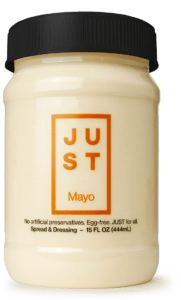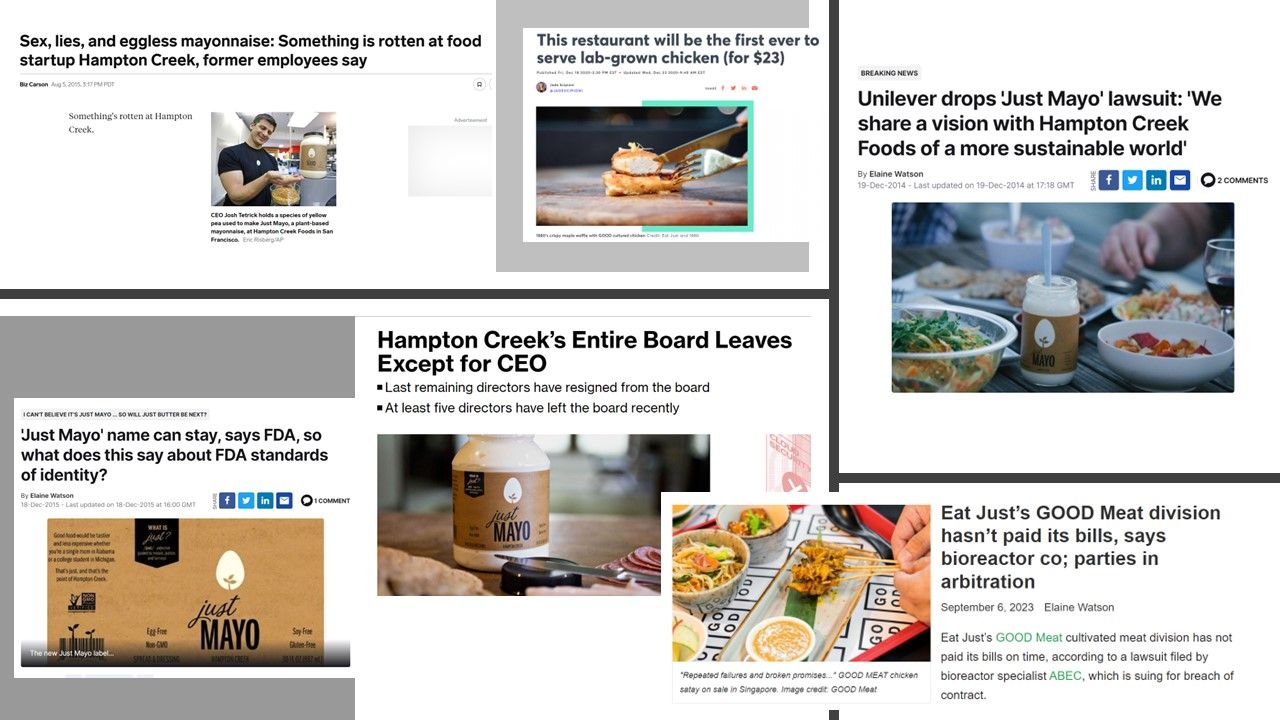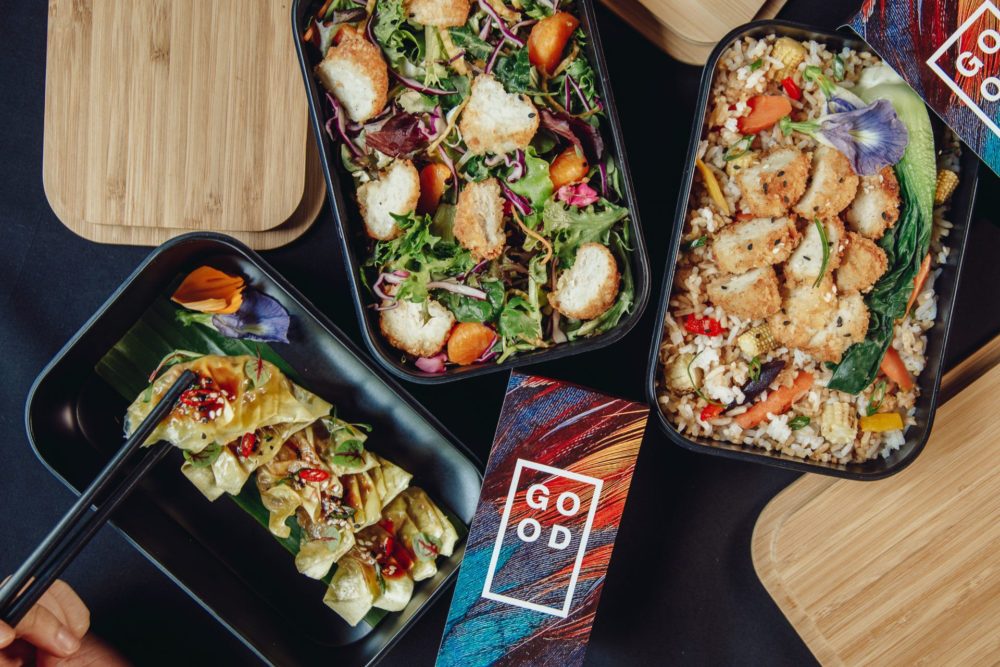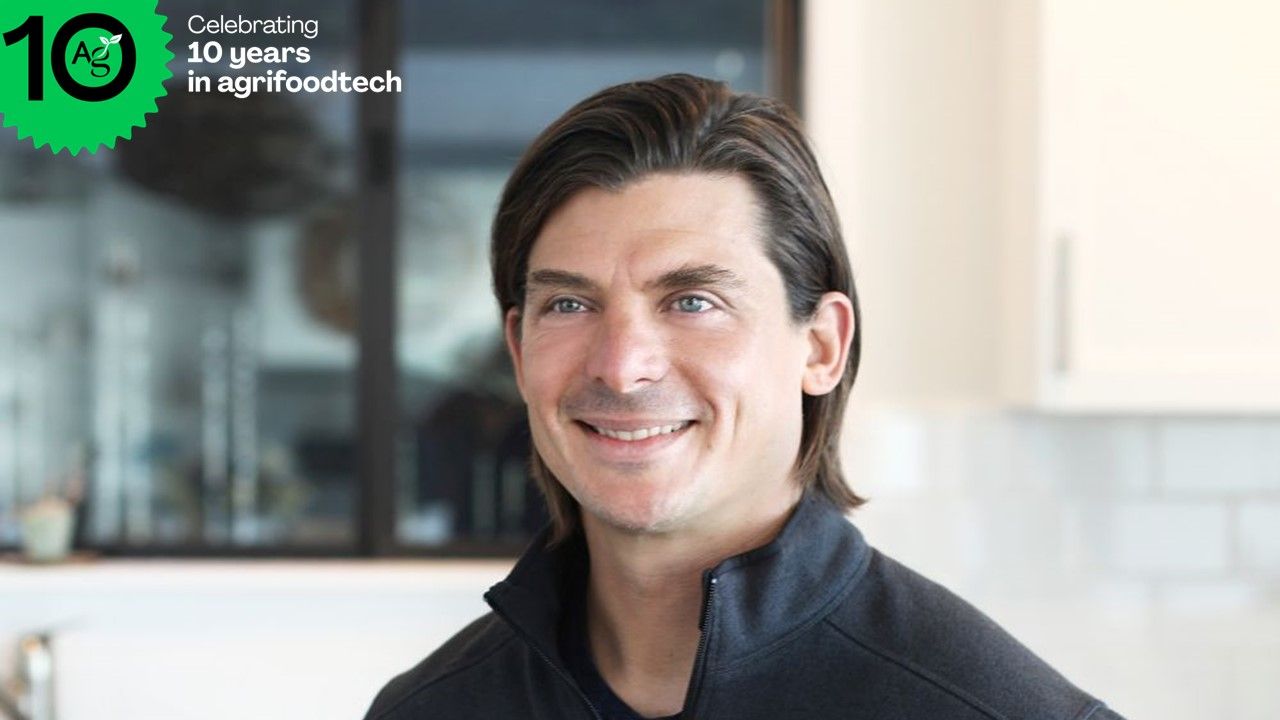Eat Just—like Beyond Meat—is often seen as a proxy for the broader alternative protein space, regarded by some as a visionary foodtech pioneer attempting to disrupt two vast addressable markets (meat, eggs) and by other less charitable observers as a “house of cards built on one individual’s ability to separate people from their money.”
Regardless of where you sit on this spectrum, says one foodtech investor we spoke to this week, it would be “pretty catastrophic” for the category if either of these loss-making firms were to crash and burn, so a lot is riding on their performance in the coming months.
So how should we view Eat Just, and can Tetrick—”one of the best capital-raisers in the business“— raise the funds to take cultivated meat from a loss-making novelty to a commercially viable alternative to animal agriculture?
‘He’s always had magical abilities to raise capital’
Armed with capital from some of Silicon Valley’s biggest spenders, California-based Eat Just (formerly Hampton Creek) first positioned itself as a b2b plant-based egg supplier, before losing patience with the lead times of large CPG companies and introducing its own consumer brands (Just Mayo, Just Cookie Dough) based on yellow pea protein to the market in 2013.
By 2019, however, cofounder Josh Tetrick was betting the house on JUST Egg, a scrambled egg alternative made from mung beans. He’d also staked a claim in the nascent cultivated meat industry via a new division called GOOD Meat, a move seen by some commentators as a costly distraction from the core business, although Tetrick clearly managed to persuade investors that it was a logical adjacency for a startup seeking to displace industrialized animal agriculture.
Tetrick—who parted company with his entire board in 2017— has emerged from all this as a somewhat polarizing figure, with some praising his strategic thinking and adaptability and others arguing that he has burned through vast amounts of cash (a jaw-dropping $850 million+ to date) for little reward, saved only by his “phenomenal” pitching skills.
One industry source told AgFunderNews: “Josh’s leadership has been a mystery for few years now. His relationship with his board, the fund raising, executives leaving the company… brought many questions.
“However, he is one of the pioneers in building the alternative protein industry and I wish Eat Just great success. We need success stories in foodtech and Josh’s persistence is remarkable.”
A second source told us: “He’s always had magical abilities to raise capital and the egg product at least is fantastic. A lot of people want to see him fail, but a lot of people also want to see him succeed. I’m in the latter camp.”
‘I don’t understand how he is still in business’
Other sources we spoke to were less charitable. “I don’t understand how he is still in business,” one alt protein investor told us this week. “He’s raised a ton of capital from people I would generally consider to be well disciplined, thorough investors, and has shown very little progress other than headlines, from my perspective. Knowing this space, I have no clue how he is still able to raise such incredible amounts of money.”
Ultimately, he said, “People shouldn’t be giving him hundreds of millions of dollars [to fund a commercial-scale cultivated meat factory] if Eat Just is what I think it is, which is just a house of cards built on one individual’s ability to separate people from their money.”
The evolving media narrative
As for the media narrative surrounding the company, the headlines were consistently positive in the early days, with Tetrick emerging victorious from spats with Unilever and the FDA over product labeling, raising bucketloads of cash, and building a CPG brand that initially appeared to be giving multinational food brands a run for their money.
Hampton Creek also appeared to be giving the American Egg Board some sleepless nights after USDA determined that the AEB had engaged in a concerted attempt to undermine Tetrick’s fledgling egg-free brand.
 In 2015-2017, however, press coverage soured, as anonymous sources briefed Business Insider about a ‘cult of delusion’ at a food company masquerading as a tech company, and Bloomberg published a stream of articles alleging fraudulent product buyback schemes for Just Mayo, boardroom squabbling, food safety issues and financial problems.
In 2015-2017, however, press coverage soured, as anonymous sources briefed Business Insider about a ‘cult of delusion’ at a food company masquerading as a tech company, and Bloomberg published a stream of articles alleging fraudulent product buyback schemes for Just Mayo, boardroom squabbling, food safety issues and financial problems.
Tetrick rode the storm, however, telling FoodNavigator-USA in 2017 that, “If you look at any company, Apple, Nike, Tesla, they hired lots of people when they were growing fast, and those people left.”
And while Tetrick acknowledged that some independent contractors had been tasked with buying Just Mayo to “stimulate sales momentum,” the amount spent on buybacks was less than half a percent of sales between 2013 and 2015, he claimed. The SEC and DOJ came to the same conclusion, he noted: “There was no ‘there’ there.”
As for Target, which abruptly dropped Hampton Creek products after receiving anonymous information alleging food safety and labeling issues, the FDA had looked into the matter and found there was no case to answer, he said.
Fast forward to 2018, and the media narrative changed again, this time for the better with the launch of JUST Egg, which looked like it could transform the company’s fortunes. This was followed by glowing press coverage about Eat Just’s GOOD Meat division, the first player to launch cultivated meat in the world (in Singapore in 2020) and the first to enter the US market —along with UPSIDE Foods— this summer.
More recently however, Tetrick has been fielding challenging questions about Eat Just’s cash reserves, after bioreactor provider and strategic partner ABEC and engineering firm CRB sued GOOD Meat for breach of contract over allegedly failing to pay its bills, although we understand the parties are “in discussions to solve this amicably.”

‘If I could go back, I’d have hired more process engineers to connect lab to large-scale commercialization’
Tetrick, who has just raised an undisclosed sum from the Ahimsa Foundation, says he’d do a few things differently in the JUST Egg business if he had his time over again (see below), but points out that Eat Just and others in the alt protein space are challenging vast established, heavily-subsidized, industries with products that have never been produced at scale.
Expecting cultivated meat—an industry that didn’t even exist a decade ago—to make a serious dent in the conventional meat industry in the short term was always unrealistic, he told AgFunderNews.
“When you’re creating two entirely new categories, you’re signing up for something that’s going to be hard. You’re signing up for something that is going to require a number of disciplines, that’s going to require you to integrate technologies from multiple industries, educate consumers on product categories that many have never even heard of before.”
And there isn’t a playbook, he said. “There’s not a template for how you make egg from a plant or meat from a cell. Our ups and downs are a part of trying to figure out how to do that.”
As for the yo-yo-ing press coverage, he said, “In my experience, sometimes externally folks think that things are awesome when things internally are much more challenging. And other times external folks think things are really hard when in fact they’re going extraordinarily well internally. So that’s just something I have come to accept.”
“If I could go back, I’d have hired more process engineers in the beginning to connect lab to large-scale commercialization, because there is a radical difference between what you can do in the lab and what you can commercialize with reasonable costs and a large scale. I would also have purchased our own protein separation facility and owned that much faster. By doing those two things, JUST Egg probably would have been out three or four years earlier.” Josh Tetrick, Eat Just

JUST Egg ‘closer to operational profitability’
The plant-based egg side of the business is “closer to operational profitability” but “still has a lot of work to do” said Tetrick, who laid off 18% of the staff at Just Egg earlier this year and has just instituted a second round of layoffs, telling Bloomberg that, “We took steps to reduce costs for the purpose of Just Egg sales covering the company’s operating expenses sooner.”
He won’t share revenues, but says JUST Egg is the dominant player in the plant-based egg space with a repeat purchase rate of 51%, distribution in 48,000+ retail points of distribution in North America, and branded partnerships with CPG companies adding an additional 10,000 points of retail distribution.
Meanwhile, foodservice sales for JUST Egg grew 15% and 39% in Q1 and Q2 of this year respectively, with launches at major airlines (United and Alaska Air), colleges and universities, and prominent burger joints and coffee chains.

Monetizing mung bean starch
However, more work still needs to be done on improving margins via more efficient sourcing of mung beans, increased scale, monetizing co-products (mung bean starch), and improving the protein extraction process, said Tetrick.
“Some of it [mung bean starch] is being sold, but overall, we need to do a lot more to create a refined functional starch, and that ultimately will be the best way to monetize that, so that’s an ongoing project.”
If he could go back, he said, “I’d have hired more process engineers in the beginning to connect lab to large-scale commercialization, because there is a radical difference between what you can do in the lab and what you can commercialize with reasonable costs and a large scale. I would also have purchased our own protein separation facility and owned that much faster. By doing those two things, JUST Egg probably would have been out three or four years earlier.”

Funding a large-scale cultivated meat facility
But what about cultivated meat? Can Tetrick secure the hundreds of millions of dollars needed to fund a larger scale commercial cultivated meat facility housing 250,000-liter bioreactors, a size that has not yet been tested in animal cell culture?
According to the lawsuit from bioreactor specialist ABEC, “GOOD Meat was woefully undercapitalized from the beginning, especially considering that the whole endeavor [building a large-scale cultivated meat facility with 10 huge bioreactors] was likely to cost more than $1 billion, with commitments to ABEC for ABEC’s portion of the project alone likely exceeding $550,000,000.”
Tetrick won’t comment on the litigation, but asked if he was confident of raising the capital needed to fund a plant on this scale, he told us: “If ‘confident’ means certain, the answer is no, but if you mean, ‘Do I think it’s much more likely than not that that we and other companies will be able to finance the construction of these first facilities?’ then yes.”
‘The first [large-scale cultivated meat] facilities are necessarily going to be more expensive’
As for the commercial viability of cultivated meat, he said, “The single biggest challenge to cultivated meat becoming the meat the world consumes, is finding a way to reduce the cost of constructing large-scale facilities [capable of producing tens of millions of pounds of meat a year].
“The first ones are necessarily going to be more expensive, but we and other companies need to figure out thoughtful ways to reduce that overall cost in the future, or else the industry won’t do what we all want it to do.”
Growing animal cells in 250,000-liter bioreactors is uncharted territory, acknowledged Tetrick. But for cell-cultured meat to be viable at scale, he said, vessel size “needs to be north of 200,000 liters, cell density needs to go up, and media costs need to be in the cents, not dollars.”
According to Tetrick: “Our approach is a fed-batch approach, leveraging the knowledge gained at large scale biopharmaceutical manufacturing. We think that approach is ultimately the best way to reduce your COGS. But with that said, we’re not the keeper of all knowledge. We need many companies out there trying all sorts of different approaches to scaling up cultivated meat, from 3D-printing to scaffolding to perfusion.
“It’s not that dissimilar from scaling up low carbon infrastructure. There are many different approaches to maximizing the efficiency of solar or wind or geothermal energy, and we need lots of experiments going on simultaneously to get to the right answer.”
Active CRISPR program
But what progress is GOOD Meat seeing in the field that makes Tetrick think that large-scale manufacturing could be commercially viable?
“When we look at the components in the media, the amino acids, the vitamins and minerals, whether food grade or pharma grade or somewhere in between, and we project buying hundreds of 1,000s, or millions of gallons, then we see a path to getting to 10s of cents per liter,” he said.
“We also have an active CRISPR program where we’re working to maximize cell densities through gene editing techniques, so that’s another way that you can reduce the cost of media, by making the cells more efficient.”
That said, “If someone says there are uncertainties around scaling up cultivated meat to tens of millions of pounds and getting below the cost of conventional chicken, beef or pork and lamb,” said Tetrick, “I agree. There are a number of technical, engineering, and capital challenges related to this industry.”
Cell phones and cultivated meat…
But that doesn’t mean that cultivated meat is a foodtech fantasy, he added: “The first cell phone that came out was this big, bulky thing. And if someone had said eventually it’ll be a phone in your pocket with 10,000 songs and access to the internet, you’d have said that can’t be because we don’t have the processing speed or the internet connectivity to do that.
“The journey of technology through time is to continue to build on the foundation you have and identify more efficient, faster, more effective ways to do things. Cultivated meat is no different.”
‘The funding environment for foodtech has pretty much mirrored other industries outside of AI’
Asked about the recent drop off in foodtech funding, Tetrick said “The funding environment for foodtech has pretty much mirrored other industries outside AI, which is to say private funding has significantly dropped.
“If you look back at funding cycles, whether AI or e-commerce or electric cars or telecommunications, you have peaks and valleys over a long period of time,” added Tetrick.
“But at the end of the day, investors want to invest capital into products and services that consumers really want. And if foodtech can achieve that, then funding is just a consequence of that.”
He added: “If alternative protein can figure out a way to make something that consumers really enjoy the taste of, that makes them feel good, that’s at a cost they can afford, it will win. And long term I think cultivated meat will be the most consumed meat, more than plant-based, and more than conventional.”

Exit strategy
So what’s the exit strategy for Eat Just?
According to Tetrick: “We’re the leading plant-based egg company and the world’s leading cultivated meat company. And both are different in their path to profitability, their path to scale up, their consumer adoption, and their regulatory path right now.
“They’re common in that they’re both sitting under the same mission, to move our food system away from large scale industrial animal agriculture. But I think eventually, the path for JUST Egg will be as a public company, and I think eventually the path for GOOD Meat will be as a public company. I don’t know whether that will be under one umbrella or it’ll be separate.”
Eat Just timeline
- 2011: Josh Tetrick and Josh Balk cofound Hampton Creek with a mission to displace industrialized egg production.
- 2012: Tetrick hires former Unilever Food Solutions global R&D director Johan Boot to his team, engages in the “systematic analysis of hundreds of varieties of plants to identify those that can replicate the function of egg in any given application.”
- 2013: Just Mayo launches in US retail market, made from a combination of canola oil, modified starches, and yellow pea protein. Check out this AgFunderNews video footage from 2013!
- 2014: Hampton Creek completes $23m Series B round led by Horizons Ventures followed by a $90m series C round led by Horizons Ventures and Khosla Ventures. Unilever, which sued Hampton Creek for false advertising in November, dropped the lawsuit in December amid a torrent of bad publicity.
- 2015: Just weeks after telling Hampton Creek it was playing fast and loose with food labeling regs by branding its egg-free spread ‘Just Mayo’, the FDA told Tetrick he could keep the ‘Just Mayo’ brand name – as long as he made minor tweaks to the label.
- 2016: Hampton Creek joins a growing number of companies sued for allegedly misclassifying workers as independent contractors as opposed to employees.
- 2017: Hampton Creek becomes Eat Just and unveils plans to enter cultivated meat market, but is dogged by reports of boardroom power struggles, a product withdrawal at Target and a trademark dispute. The DOJ and the SEC find no evidence of wrongdoing in the wake of allegations that the company had orchestrated an internal buyback scheme in 2014 designed to artificially inflate its sales figures.
- 2018: Launch of JUST Egg. One of the first – but most challenging – products the company started working on, JUST Egg is made from water, mung bean protein isolate and canola oil, and designed to look, cook, and taste, just like scrambled egg.
- 2019: JUST Egg gains traction in the retail market: “There are few examples of a plant-based product outselling an animal-based product in national distribution — this is one of them.”
- 2020: GOOD Meat—the world’s first cultivated meat brand—launches in Singapore; Tetrick predicts operational profitability in late 2021, and mulls IPO.
- 2021: Eat Just’s mung bean protein receives novel foods approval in the EU.
- 2022: GOOD Meat signs exclusive seven-year deal with bioprocess equipment specialist ABEC to design, manufacture, install and commission the “largest known bioreactors for avian and mammalian cell culture” in a large-scale facility in the US.
- 2023: GOOD Meat launches in the US after securing the regulatory green light from the FDA and USDA. ABEC and CRB sue Eat Just and GOOD Meat for breach of contract over alleged non-payment of bills.
Click here to download AgFunderNews’ FREE report documenting the last 10 years in agrifoodtech!




